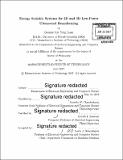Energy scalable systems for 2D and 3D low-power ultrasound beamforming
Author(s)
Lam, Bonnie K. Y. (Bonnie Kit Ying)
DownloadFull printable version (16.69Mb)
Other Contributors
Massachusetts Institute of Technology. Department of Electrical Engineering and Computer Science.
Advisor
Anantha P. Chandrakasan and Gerald J. Sussman.
Terms of use
Metadata
Show full item recordAbstract
In traditional ultrasound imaging systems, bulky and power-intensive mainframes are used to process the high number of waveforms acquired in parallel from a large transducer array. The computational power of these systems scales linearly with transducer count. However, there exist applications where basic functionality in low-power conditions may be favorable to an "all-or-nothing" system that only produces a high resolution image when enough power is supplied. This thesis presents systems designed to support energy-scalability at run-time, enabling the user to make the tradeoff between power and performance. First, a system-level energy model for a receive-side digital beamforming system is presented. Power-performance tradeoffs for the analog front-end, analog-to-digital converter, and digital beamformer are analyzed individually and then combined to account for the performance dependency between the functional components. These considerations inform a recommendation on design choices for the end-to-end system. Second, this thesis describes an energy-scalable 2-D beamformer that provides user-controlled run-time tradeoff between image quality and energy consumption. Architectural design choices that enable three operating modes are discussed. A test chip was fabricated in 65-nm low power CMOS technology. It can operate with functional correctness at 0.49 V, with a measured power of 185 [mu]W in real-time operation at 0.52 V. Finally, a software-based energy-scalable 3-D ultrasound beamformer is implemented on an embedded supercomputer. The energy consumption and corresponding imaging quality are measured and compared.
Description
Thesis: Ph. D., Massachusetts Institute of Technology, Department of Electrical Engineering and Computer Science, 2017. Cataloged from PDF version of thesis. Includes bibliographical references (pages 119-125).
Date issued
2017Department
Massachusetts Institute of Technology. Department of Electrical Engineering and Computer SciencePublisher
Massachusetts Institute of Technology
Keywords
Electrical Engineering and Computer Science.